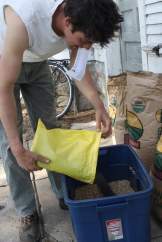 This week, we have a new addition to the Oxheart Farm flock: laying hens. We are thrilled to have 40 Buff Orpington hens scratching happily at our lush winter rye cover crop, and laying beautiful brown eggs. These ladies will provide for an Egg CSA share, eggs for the Mt. Horeb Farmers’ Market, as well as fertility for our fields as we rotate them in their mobile fence. We will begin selling eggs next week. Check back for details soon.
This week, we have a new addition to the Oxheart Farm flock: laying hens. We are thrilled to have 40 Buff Orpington hens scratching happily at our lush winter rye cover crop, and laying beautiful brown eggs. These ladies will provide for an Egg CSA share, eggs for the Mt. Horeb Farmers’ Market, as well as fertility for our fields as we rotate them in their mobile fence. We will begin selling eggs next week. Check back for details soon.
Happenings
Market-style CSA: a Choice in the Matter
The Market-style CSA is by no means new. CSA farms all over the country have done it for ages. For many CSAs, especially those that deliver long distances to cities, it makes sense to pack boxes and load them into a delivery van to send to workplaces, churches, and homes. For Oxheart, where our focus is on our smaller local community, we are able to invite members to our farm to pick up their CSA share. This farm pick-up gives people a choice in the matter, every single week.
But how do members get to choose what goes in the box they take home? There are many different ways that farms have used to give their members options– here’s the way it works at Oxheart. Each week, you come to the farm with your own bag/crate/box. We have a stand set up– much like a tent at a farmers’ market– with a spread of everything we are harvesting that week. The various veggies are arranged in groups with like products: lettuce mix, spinach, and arugula are all in one area; carrot, beet, and salad turnip bunches are together somewhere else. Nearby the veggies hangs a chalkboard, a “menu” so to speak, listing all that is available and what the choices are. For example, from the “greens” category, you may choose any two bags. It could be one spinach and one arugula, two bags of lettuce mix, or any other combination. Then from the “staples” category, you may choose 10 pounds of any combination of onions, potatoes, and squash. In the summer, we have options for bulk items for preserving– tomatoes, cucumbers, herbs, etc.
If there’s something you don’t like, you never have to take it. Or if you like it but you’re sick of it, you can skip it for a week. If you know you want a lot of something for a special dish, you can stock up as long as it’s not in short supply.
So if it’s so much like a farmers’ market, why sign up for a CSA share at all? Our members’ commitment to our farm early in the season gives us certainty that we have mouths to feed all season. This knowledge, along with the up-front payment, makes the CSA a good deal for us. And because it’s a good deal for us, we’re able to make it a good deal for you: the approximate $30/week value that our members pay is exceeded in vegetables on almost a weekly basis (which we love as much as anything!).
Email us with questions! Sign up for a share! We look forward to feeding you.
(An easy) Row to Hoe
The snow may be blowing outside, but warm and toasty inside we’re scheming for the coming season. Ordering seeds, finding piglets, and today, putting a new handle on our Row Hoe.
When we picked up the old Row Hoe from a friend, neither of us realized how useful it would prove. It may be a rusted old garden tool from the era of the victory garden, but when I first took it by the handle and pushed it through the soil I was astounded at the ease with which it cleaned the weeds from between a row of onions. Simple but elegant in it’s design, an 8″ diameter cast iron roller wheel loosens the soil ahead of a knife that cuts the weeds off an inch or so below ground level. Or, simply flip the handle over and push it the other direction to engage several knives to uproot mid-sized weeds.
After a month or two of heavy use this past summer, the (70 year old) handle broke. In the hustle and bustle of late summer, we turned to our other wheel hoes instead of fixing the Row Hoe, but each time remarked on the Row Hoe’s superiority.
Now that the Row Hoe is fixed, this might be the first time I’ve been excited for the weeds to sprout!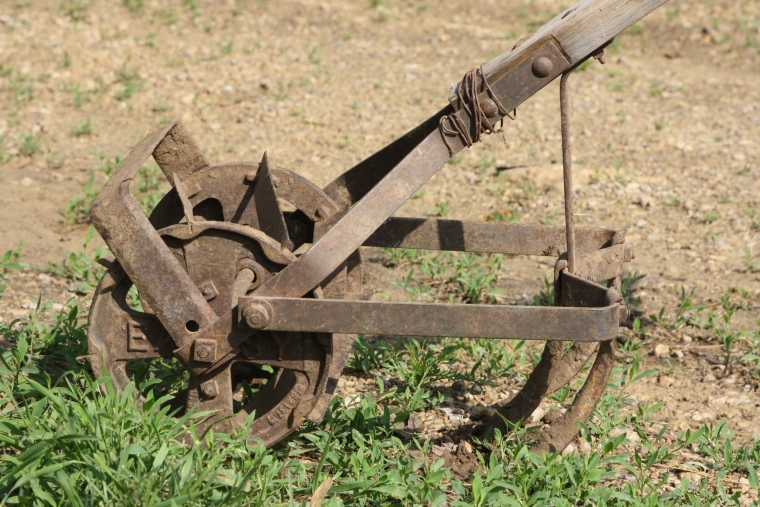
Getting away from the feed bag
July 21, 2013
Wednesday, a cool summer day, we butchered the last of our Freedom Ranger meat chickens. Of course this part is not nearly so fun as getting the chicks in the mail. Still, it feels good to carry out our responsibility as eaters and farmers and end their short but happy lives as cleanly and calmly as we can. They did well by us, and we by them.
As planned, the birds weighed in at between 4 and 4.5 pounds, with a few five pounders and a couple small birds. This was a pleasing affirmation of our feed quality and feed regime.
Back in the winter we drew up a budget for our meat chicken enterprise as part of our Farm Beginnings business planning class. We had raised meat chickens the year before at Hungry Turtle farm in Amery, so we had a good idea of what our expenses would be. We set up the budget and put the feed cost as a variable to see how it would affect our profit. Feed accounts for the majority of the budget.
We shifted the cost of feed in the spreadsheet until the profit margin started to look like a worthwhile enterprise. Somewhere around $0.30/lb. Bagged organic chicken feed from Cashton, Westby, or Mt Tabor at the time ranged from $0.55 – 0.60/lb (it’s dropped a few cents since).
By purchasing bulk grain from a nearby farmer and supplementing with some minerals and the feed mills, we were able to feed our birds for an average of $0.35/lb. We fed Cashton Organic chicken starter for three weeks and then transitioned to a mixture of Organic cracked corn, whole sprouted transitional-Organic oats, Cashton organic alfalfa pellets, kelp meal, minerals, and salt.
We switched over to the new grain mix too soon and too quickly. The feed that we mixed was much lower protein, although since the birds were on pasture eating lots of bugs, it’s hard to say exactly how much protein they are getting. In any case, their growth slowed and we started to worry. In an attempt to up the protein content we fed more sprouted outs. They love the oats and gobble them right up. But our little chickens crops were barely equipped to digest the fibrous oats, and ballooned up until they looked lopsided. There’s a part to every learning experience called the pit of despair. This was it. We reintroduced the bagged feed to their diet, and slowly weaned them off of it again, this time over the course of three weeks.
From there on, we fed only our own mix, and in the last two weeks fed nearly half sprouted outs, with clear weight gains.
There’s One hundred twenty-five baby chicks out in the yard–here we go again. It will be interesting to see how this batch works out, as we try to get away from the feed bag.
Oxheart Farm Eats
One of our favorite things about farming… is eating. We also love to cook beautiful, tasty, filling meals for our household and friends.
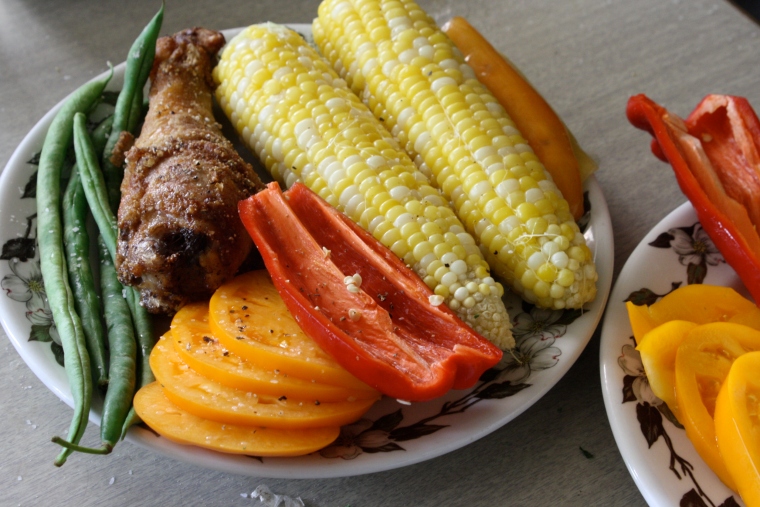

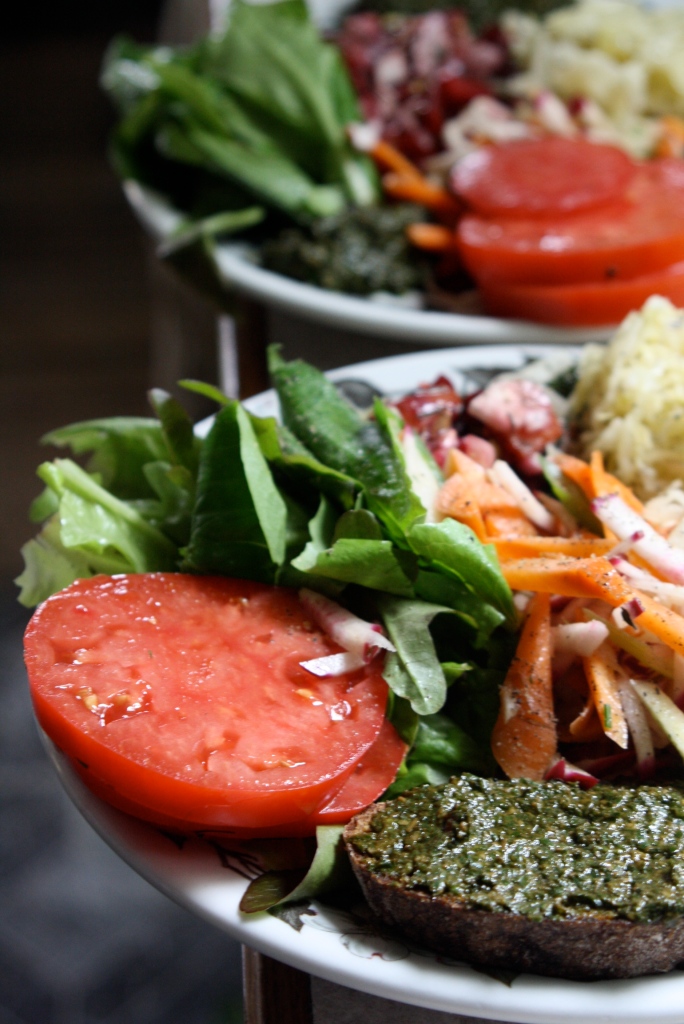
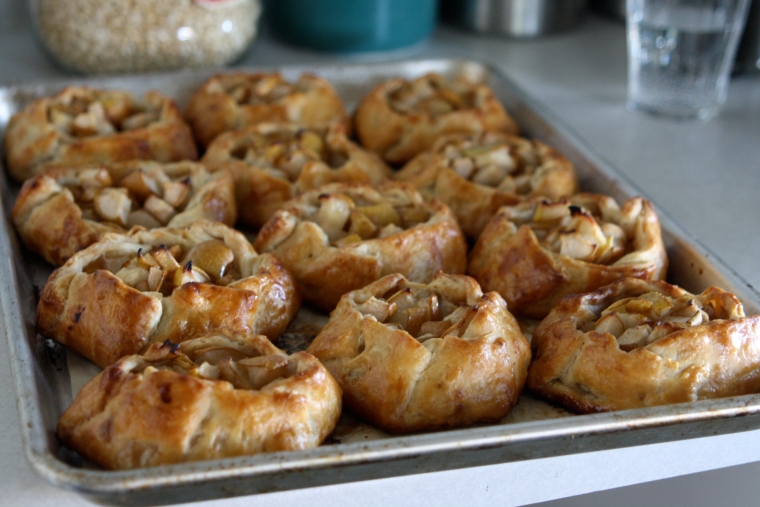
Debut Showing
Thursday June 20th will be our first week selling at the Mt Horeb Farmers market from 3 – 6:30 pm in the pocket park just off the main drag under the water tower. Cella will be bringing in Lettuce, Beets, Kale, Chard, Spinach, and assorted herbs.
Something fun that we are going to try is delivering our produce to the market by bicycle. We live only three miles from town. We don’t anticipate that the savings in fossil fuel from this venture will save our altering climate; however, we do hope to turn some heads. Nobody needs to see what’s possible with a half-ton pick up truck–but maybe we can increase our own confidence in what’s possible without one and do our best to look a changing world in the eye.
Pigs on the Premises
We’ve been pushing our way through this cold, slow spring– peas, roots, onions, and brassicas are green in the field; the chicks are growing by leaps and bounds; and little sprouts are poking up in the pig forage plot. But until yesterday, something was missing. It somehow just didn’t feel like a farm yet. After weeks of anticipation (and some preparation), our eight Mulefoot piglets finally arrived. They came from two litters– both around two months old– on a farm about half an hour south of here. The pigs arrived in a cat carriers in the back of a truck, and though we had a non-electric backup fence set up to receive them into, they didn’t flinch when we unloaded them. They set right to grazing the second we let them out.
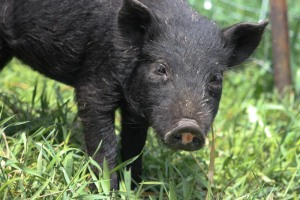 While most pigs would race for the pan of grain, these kids spent the whole afternoon munching happily on the fresh green grass in their pen, or napping in a pile under the hay in their house. Each pig took a turn sitting in the water tub, as it was a warm afternoon, and only occasionally they would nose through the grain in their trough.
While most pigs would race for the pan of grain, these kids spent the whole afternoon munching happily on the fresh green grass in their pen, or napping in a pile under the hay in their house. Each pig took a turn sitting in the water tub, as it was a warm afternoon, and only occasionally they would nose through the grain in their trough. 
When we let them out into the big electric fenced yard, the piglets took turns testing the fence (ouch!), then went back to grazing enthusiastically. They seem like wonderfully good-natured little pigs, and their excitement for the green pasture gives us hope that our planned forage will work well with this breed.
With the pigs in the pasture, it really feels more like a farm around here. We’re excited to see what the season will bring with these new pigs– for now we’re just glad to have them around.
Sowing the Pig Field
 The pigs don’t arrive for a week still, but today we began seeding the area that will be their summer salad (and grain) bar. Yesterday Emmet tilled about 1/4 acre and today we seeded about half of it into a forage mix for the pigs to “hog down.” In the first section we planted peas, oats, spring wheat, spring barley, triticale, turnips, kale, and tillage radishes. This will be the pig’s late spring/early summer forage. In the midsummer, before corn and clover come into the mix, they will have many of the same grains, brassicas, and legumes as before, but with the addition of vetch, clover, and alfalfa. We also seeded these today.
The pigs don’t arrive for a week still, but today we began seeding the area that will be their summer salad (and grain) bar. Yesterday Emmet tilled about 1/4 acre and today we seeded about half of it into a forage mix for the pigs to “hog down.” In the first section we planted peas, oats, spring wheat, spring barley, triticale, turnips, kale, and tillage radishes. This will be the pig’s late spring/early summer forage. In the midsummer, before corn and clover come into the mix, they will have many of the same grains, brassicas, and legumes as before, but with the addition of vetch, clover, and alfalfa. We also seeded these today.
(Above: the seed mix of grains, brassicas, and legumes. Below: Emmet mixing the seed, and broadcasting it in the field)
Mail Delivery
At six o’clock on Friday morning, the phone rang with an unfamiliar number. The call, however, was 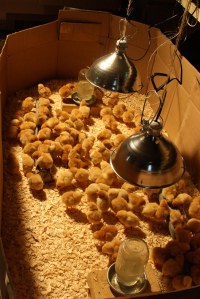 one I’d heard before. Without needing to hear the message, I knew it said (in so many words), get this racket out of here. Half an hour later I was knocking on the door of the still-closed Mount Horeb post office, and the woman who opened the door looked relieved that I’d come. Behind her among the stacks of unsorted letters and packages was a box, chirping at a volume far too loud and perky for the hour: a hundred Freedom Ranger chicks had arrived from the Pennsylvania hatchery.
one I’d heard before. Without needing to hear the message, I knew it said (in so many words), get this racket out of here. Half an hour later I was knocking on the door of the still-closed Mount Horeb post office, and the woman who opened the door looked relieved that I’d come. Behind her among the stacks of unsorted letters and packages was a box, chirping at a volume far too loud and perky for the hour: a hundred Freedom Ranger chicks had arrived from the Pennsylvania hatchery.
 The new chicks are the first real life of this growing season on the farm, aside from the tiny plants growing in our cold frame. Having them here feels like a real beginning. Since their arrival, they have been keeping warm and busy in their new home in the basement. They’re cute and fluffy now– within a week they will begin to grow wing feathers and outgrow their basement home. Once it’s warm enough, we will move them out into their mobile house with a heat lamp at night for warmth.
The new chicks are the first real life of this growing season on the farm, aside from the tiny plants growing in our cold frame. Having them here feels like a real beginning. Since their arrival, they have been keeping warm and busy in their new home in the basement. They’re cute and fluffy now– within a week they will begin to grow wing feathers and outgrow their basement home. Once it’s warm enough, we will move them out into their mobile house with a heat lamp at night for warmth.
Progressive Pork
 In the Madison area, pasture raised pork seems relatively easy to find. I wonder though if most people understand the difference between pasture raised pork and grass fed beef. Although cows, as ruminants, can (some say should) thrive on grass alone, pigs are omnivores just like humans. A pig can’t live on grass alone much better than a human could.
In the Madison area, pasture raised pork seems relatively easy to find. I wonder though if most people understand the difference between pasture raised pork and grass fed beef. Although cows, as ruminants, can (some say should) thrive on grass alone, pigs are omnivores just like humans. A pig can’t live on grass alone much better than a human could.
With the rising price of organic grain, our goal is a pasturing system for pigs that offsets the feed bill more than grass and roots alone. This year our hog pasture will look a lot less like rolling grassland and a lot more like a vegetable garden. Our plan is to plant high energy and high protein crops in succesion for the pigs to ‘hog down.’ The first planting will include turnips and a mix of spring grains like oats, barley, wheat, and triticale. We’ll add clover to that mix for later in the summer. The early fall planting will be field corn with clover in between the rows. Late fall will look a lot like the first planting, but with winter grains like winter rye and wheat replacing the spring grains with the turnips.
Essentially we’ll be growing cover crops that the pigs will eat and uproot, adding to the fertility of the soil and preparing a seed bed for future crops all at the same time, with a fabulous bi-product: pork! Of course, this is still a hope and dream, so stay tuned.
Wish us luck in our experiment. If all goes well, we’ll cut our feed bill considerably and have superior meat that is something more than free range or grass fed–and I think we’ll be able to taste the difference.





